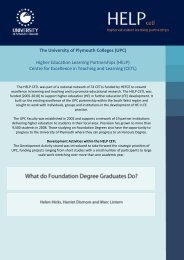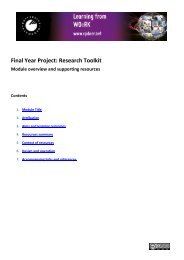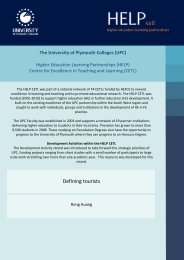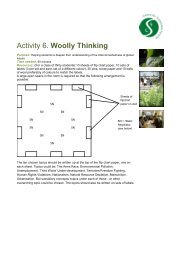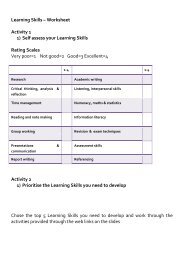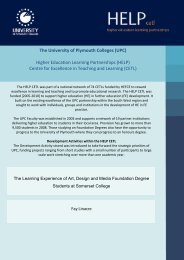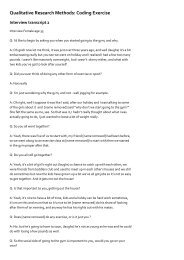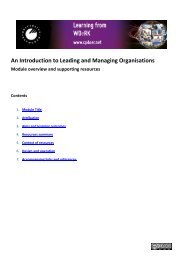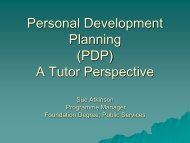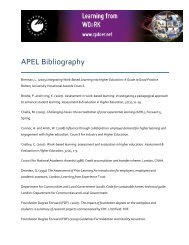Activity 3 Diamond Ranking .pdf
Activity 3 Diamond Ranking .pdf
Activity 3 Diamond Ranking .pdf
- No tags were found...
You also want an ePaper? Increase the reach of your titles
YUMPU automatically turns print PDFs into web optimized ePapers that Google loves.
<strong>Activity</strong> 3. <strong>Diamond</strong> <strong>Ranking</strong>HerePurpose: Helping students to clarify and explore their own value positions, feelings andthoughts regarding controversial sustainability-related issues, as well as to negotiate forconsensus buildingTime needed: 45 minutesResources: The same nine briefing statements or anecdotes representing a spread ofopinions or perspectives for each pair of students. (Each statement should be given a short titleor number for easy reference and each set of statements should be cut up and stored in anenvelope. See Appendix 1 below for two examples.Procedure:Pairs are given an envelope containing the nine statements/anecdotes and areasked to rank the statements in diamond formation, i.e12 24 4 47 7A fairly loose criterion for ranking is given such as ‘importance’, ‘significance’,‘convincing,’ ‘interesting’, the facilitator resisting any request for her to be morespecific about the criterion. The most ‘important’, ‘significant’, ‘convincing’ or‘interesting’ statement/anecdote is placed at the top of the diamond. The nexttwo are placed in second equal position. The three across the centre are fourthequal. The next two are seventh equal. The statement/anecdote placed at thefoot of the diamond is the one considered by the pair to be the least ‘important’,‘significant’, ‘convincing’ or ‘interesting’. When pairs have completed their task,they form into sixes. Each pair explains and seeks to justify its ranking to theother two pairs. The six then try to negotiate a consensus ranking for the groupas a whole. Plenary reporting back and discussion follow.9
Potential:HereThis activity helps students in an unthreatening way to clarify what their thoughtsand feelings about a particular subject are whilst alerting them to a range ofother opinions and perspectives on the subject. Underpinning the activity is theunspoken assumption that everybody has something relevant and valuable tobring to the discussion. The imprecise criterion given is itself likely to be onelayer in the discussion. What does ‘important’, ‘significant’, ‘convincing’ or‘interesting’ mean? Should we try and pin down what we mean more precisely?Skills used in the activity include discussion, negotiation, accommodation toother perspectives, and consensus-seeking. In the plenary discussion, a groupreporting their inability to agree upon a ranking order is as important adiscussion point as group reporting that they have achieved consensus.Variation:Cartoon can be used to good effect in this activity; for instance nine cartoons onclimate change.Source: Graham Pike and David Selby (1988). Global Teacher, Global Learner. Hodder &Stoughton, London.pp.134-135
Appendix 1.HereExample A (by Stephen Sterling)1. ESD is potentially too controversial for educationto engage in. It’s not the function of education to change the world!2. ESD is aimed at changing students’ values and behaviour.In particular, it should be skills and action-oriented.3. ESD should concentrate on exploring the meaning of sustainability valuessuch as biodiversity, community, equity, the rights of future generations, and economicsecurity, and interpreting these to students. Addressing values is more important than‘sustainability skills’.4. ESD goes beyond environmental education (EE) and includes it, by working moreexplicitly with social, economic, political and ethical dimensions. It is the logicalsuccessor to EE.5. The main task of ESD is to help people understand the various views of SDand their implications, rather than try effect a change of thinking in people towards anyparticular orientation.6. It’s not fair to lay the world’s environmental and sustainability problems at the feet ourstudents – it’s more likely to induce fear and guilt than empowerment for constructivechange.7. ESD is transformative – it implies a change of educational culture towards somethingmore integrative, process-oriented and dynamic. It emphasises the importance of criticalthinking, and systems thinking, and of social learning and democratic process.8. ESD is too vague and contested a concept to be dealt with in an adequate way bymost teachers. What’s more, it’s potentially doctrinaire. Let us just concentrate on goodeducation.9. The world’s problems are too severe for the gradual emergence of ESD. What areneeded are clear definitions, top-down strategies, and measurable indicators andoutcomes. Tell what it is, and we’ll do it!.
Example B (by David Selby)HereEcofeminism endorses sustainabilityAn ecofeminist vision of sustainability goes fullcircle, integrating humans and environment,linking analysis with action, and women with theearth. Its earth-vision incorporates a spectrumof beliefs and concepts essential to integratethe material with the spiritual and the localcommunity with the global. Ecofeminism thusendorses the concept of sustainability. It alsounderstands that only a fundamental and rapidshift of values and action will ensure thesurvival of life on earth.- Melody HessingWhat does ESD leave out?It is tempting to think that environmental conflictscan be addressed by talking about sustainabledevelopment. But there are significant schools ofthought concerning humanity’s relationship withthe environment that sustainability discourseexcludes or straitjackets, such as animalliberation, bioregionalism, deep ecology,ecofeminism (that links the oppressions of natureand women) and environmental justice (thatidentifies environmental problems as socialjustice problems in terms of who causes and whoexperiences their worst effects). Students need tospeak confidently about assumptions, lifestyles,worldviews, and conceptions of human place andpurpose in ecosystems. And space must befound for them to discuss cultural differences,respect, society-nature relationships, andtensions between the intrinsic and instrumentalvalue of the other-than-human.– inspired by Bob JicklingEco-designA first step in sustainability is eco-literacy, thatis, understanding the principles of organizationcommon to all living systems and that sustainthe web of life. The principles are: networks,cycles, solar energy, partnership, diversity,dynamic balance. Our system and processes ofeducation should be built around theseprinciples.- Fritjof CapraProgressive secular materialismThe sustainability ideal rests on the uncritical,unexamined acceptance of the traditionalworldview of progressive secular materialism. Itregards that worldview as completely benign aslong as it can be made sustainable. …We mustmake our priority in dealing with the Earth thecareful and strict preservation of the billion-yearoldheritage achieved by the evolution of plantand animal life.- After Donald Worster
Especially engineersSustainability literacy is a basic skill thateveryone, especially engineers, should have.- Lord SainsburyInner selfWe need to question whether, in its eminentlyjustifiable focus on critical thinking about theworld out there, education for sustainabilityhas given sufficient profile to inner explorationand has, thus, colluded with mechanism byimplying that the inner self is outside thepicture, outside the universe. To counteractthis means working with relational modes ofknowing that address our inner connectivitiesof body, mind, emotions and spirit, and thedeep connectivities between self and nature.– David SelbyNot the job…The issue is not whether sustainabledevelopment is a good or bad idea. It is aboutthe basic rights and responsibilities ofuniversities and the need to safeguardacademic freedom. It is not the job ofuniversities to promote a particular orthodoxy(sustainable development); it is their role toeducate students to examine critically policies,ideas, concepts and systems, then to make uptheir own minds. Sustainable development isdefined as a “systems view of the humancondition (blah blah blah…). Since when hasit been the duty of universities to promote aparticular religious or pseudo-scientificanalysis of what is essentially a politicalissue?– Peter Knight, VC, University of CentralEngland, in response to the HEFCEconsultative document on SDLifelong LearningWider participation in lifelong learning isexpected to enable people to become moreaware and knowledgeable aboutenvironmental issues and the ways in whichthey might lead a more sustainablelifestyle…increased levels of knowledge andskills are the means of developing innovativesolutions to the problems of sustainabledevelopment.– The Scottish Executive
The purpose of a universityThere have long been debates over thepurpose of universities. Should they seek toeducate the ‘whole person’? Is their primaryfunction to undertake research and developprofessionals for a growth economy? Shouldthey seek to subvert, so fulfilling the rebelrole of tearing open taken-for-grantedunderstandings? In the present daycentralized ‘culture of compliance,’universities tend to fulfill a conformative orreformative rather than transformativefunction. Education for sustainabledevelopment is touted by its advocates astransformative, but, in its embrace of thegrowth principle and a ‘resource’ view ofnature, it is part of the ‘culture ofcompliance.’ It fails to rattle the social cage,to promote radical reassessment of how welive, as climate change and other threatscaused by untrammeled growth take us tothe cliff edge.– inspired by Ed O’Sullivan and SandySteen




